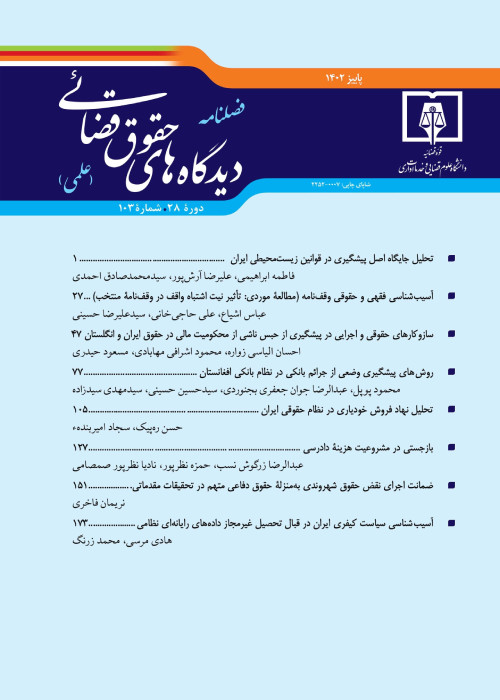The Reflection of the Knowledge and Culture Contemporary to Islam's Lawgiver in Its Narrations about atonement
Author(s):
Abstract:
Certain crimes have been committed at the time of the Imams, and people have asked them of the atonement verdict. In some cases, the narrators have asked them of an assumed crime. None of these crimes have happened in a void, or in the mind of an empty minded narrator. They are all derived from the special circumstances of that period. So, careful examination of the crimes described in narrations about their atonement brings us a better understanding of the following: What those people knew of human body, the kind of instruments which were used to measure the severity of a crime, common instruments by which crimes were committed, the kind of crimes which were either committed or were imaginable for the narrators in that period, and finally, common properties which were regarded as valuable generally or in special regions.
These are all reflected in the narrations accounting for different atonements. It is, therefore, important to pay attention to these period characteristics mentioned in the narrations (regarding anatomy, criminology, and the properties assigned as atonement) in order to derive religious laws on atonements for crimes committed today. A Faqih (Islamic Jurist) cannot disregard the special implications of those times which possibly formed a part of the subject of the verdict. The knowledge and culture of that time could –at least– in some cases restrict the instructions of the Imams regarding atonement to their specific era. It is impossible to derive the “rulings on atonements” from the “Islamic narrations” without getting to know about the cultural background in which they were issued and without comparing them to the cultural backgrounds of the time when these rulings are being derived. An updated derivation of rulings on atonements requires deriving these laws from the four major sources in such a way that “the anatomy, instruments used to measure the severity of the crime, common instruments by which crimes are being committed, types of crimes, and suitable properties to be paid as atonement” are more compatible with the time of deriving these laws.
These are all reflected in the narrations accounting for different atonements. It is, therefore, important to pay attention to these period characteristics mentioned in the narrations (regarding anatomy, criminology, and the properties assigned as atonement) in order to derive religious laws on atonements for crimes committed today. A Faqih (Islamic Jurist) cannot disregard the special implications of those times which possibly formed a part of the subject of the verdict. The knowledge and culture of that time could –at least– in some cases restrict the instructions of the Imams regarding atonement to their specific era. It is impossible to derive the “rulings on atonements” from the “Islamic narrations” without getting to know about the cultural background in which they were issued and without comparing them to the cultural backgrounds of the time when these rulings are being derived. An updated derivation of rulings on atonements requires deriving these laws from the four major sources in such a way that “the anatomy, instruments used to measure the severity of the crime, common instruments by which crimes are being committed, types of crimes, and suitable properties to be paid as atonement” are more compatible with the time of deriving these laws.
Keywords:
Language:
Persian
Published:
Judicial Law Views Quarterly (Law Views), Volume:24 Issue: 84, 2019
Pages:
165 to 196
magiran.com/p2000240
دانلود و مطالعه متن این مقاله با یکی از روشهای زیر امکان پذیر است:
اشتراک شخصی
با عضویت و پرداخت آنلاین حق اشتراک یکساله به مبلغ 1,390,000ريال میتوانید 70 عنوان مطلب دانلود کنید!
اشتراک سازمانی
به کتابخانه دانشگاه یا محل کار خود پیشنهاد کنید تا اشتراک سازمانی این پایگاه را برای دسترسی نامحدود همه کاربران به متن مطالب تهیه نمایند!
توجه!
- حق عضویت دریافتی صرف حمایت از نشریات عضو و نگهداری، تکمیل و توسعه مگیران میشود.
- پرداخت حق اشتراک و دانلود مقالات اجازه بازنشر آن در سایر رسانههای چاپی و دیجیتال را به کاربر نمیدهد.
دسترسی سراسری کاربران دانشگاه پیام نور!
اعضای هیئت علمی و دانشجویان دانشگاه پیام نور در سراسر کشور، در صورت ثبت نام با ایمیل دانشگاهی، تا پایان فروردین ماه 1403 به مقالات سایت دسترسی خواهند داشت!
In order to view content subscription is required
Personal subscription
Subscribe magiran.com for 70 € euros via PayPal and download 70 articles during a year.
Organization subscription
Please contact us to subscribe your university or library for unlimited access!



